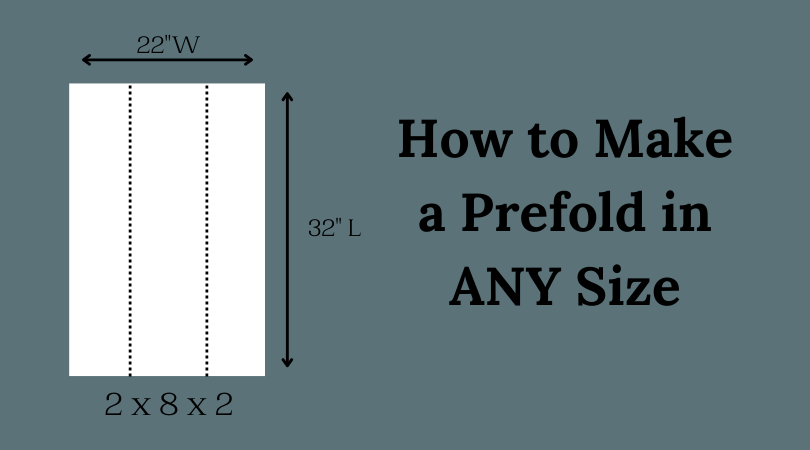Making your own adult prefold diapers may require a little math, but allows you to customize the diaper to your needs. Prefolds are one of the most versatile styles of diapers as they can be folded and used a multitude of ways. Wrap them around your body in one of a million ways or pad fold them to use in pocket diapers.
When you sew your own prefold diapers, you also get the added benefit of choosing your ideal fabric and number of layers.
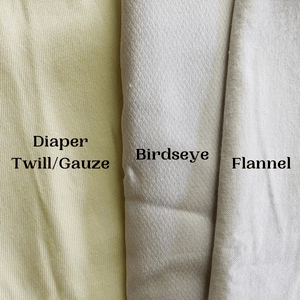
What Fabric are Prefolds Made From?
First, semantics.
A prefold diaper is made from one long layer of fabric that has been folded multiple times before being sewn to create the desired number of layers.
They are typically made from a few types of fabric: birdseye, diaper twill, or gauze. Flannel ones are also available, but tend to be quite a bit more expensive. But hey, when you make your own, you can use flannel – even the pretty colors and patterned kind if that floats your boat!
Fabric Types
What makes birdseye, gauze, and diaper twill popular prefold fabrics is that the fabric is super thin, allowing for multiple layers to be created without adding bulk and increasing drying time. Twill and gauze are VERY similar. The only difference is in the way the fibers are woven in the fabric. Twill is woven in a diagonal step weave, while gauze is a loose weave fabric.
Flannel tends to get decent reviews, but also takes a lot longer to dry. Just note that regular flannel (and the printed stuff) is a much lighter weight than diaper flannel. So if you’re looking for a sturdy quality of flannel, make sure to buy the diaper stuff.
If you decide to use a thicker fabric like terry or fleece, keep the numbers of the outside layers to 2 to help keep drying times more manageable….and don’t try to do 10 layers in the middle, lol!
How to Understand Prefold Numbers
True prefolds come with number designations like 2x8x2 ply, or 4x10x4 ply, among others. These numbers refer to the number of layers in each part of the prefold. A prefold is divided into 3 panels with the biggest number referring to the center panel.
Prefolds that have a different type of fabric sewn into the center panel are not true prefolds and do not come with a number designation.
** If you are interested in making a prefold, but don’t want to do all the folding, you could definitely make one with a different, absorbent type fabric in the center. For example, terry, fleece, zorb, etc.
Just follow steps 1-3 below to find dimensions and sew the heavier fabric in the center. ***
Calculating Fabric for Sewing a Prefold
Step 1: Decide on what dimensions and ply you want your prefold to be.
For this example, I will be calculating fabric needs for a single prefold with dimensions of 32”L x 22” w and 2x8x2 ply.
Step 2: Multiply total width by 2 and add 1” for seam allowance.
**If sewing a 4 ply prefold, multiply width by 4**
My prefold is 22” wide. 22 x 2 + 1 = 45”
Doubling the fabric would give me a prefold of 2x2x2 ply. So now we need to calculate the extra fabric for the center panel.


Step 3: Calculating center panel width.
Divide width by 3.
22/3 = 7.3
Now, decimals are fine, but the .3 would most closely be translated to 5/16, which while doable, makes the process more complicated. But that’s just me. Another benefit of rounding up is not just that it makes calculations easier, but it also makes the center panel wider.
So for our example, my center panel will be 8” wide. To find the width of the other 2 center panels, subtract center panel width from total width and divide by 2.
22 – 8 = 14
14/2 = 7
So my final folded panel dimensions will be 7”x8”x7.”
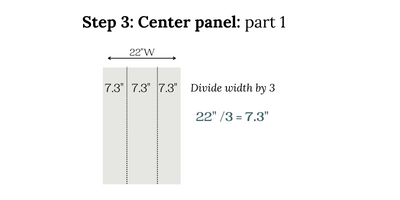
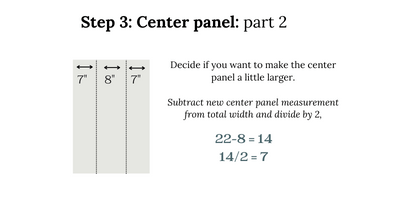
Step 4: Calculating fabric for center panel.
If I need 45” to create a 2x2x2 ply prefold, I’ll have to figure out how much more fabric I need to create an additional 6 layers for the center panel. That will give me 8 layers total for the center.
Multiply center panel width x additional desired # of layers. 8” x 6 = 48”

Step 5: Calculating width of fabric needed.
Add together your total from step 2 with total from step 4.
45” + 48” = 93.”
So I need a total of 93” in width to create a 2x8x2 prefold that is 32” L x 22” W.
I’m using birdseye fabric for this example and 1 yard is 36”L x 38”W. To find how many cuts of fabric I need, I will divide the total width needed for prefold by fabric width.
93”/38” = 2.45 = 3 cuts of fabric
**I will also need to add an extra half inch for seam allowance for each cut, since it will require 3 cuts of fabric to make the total width.**
93” + 1.5” (seam allowance) = 94.5” fabric width
Step 6: Calculating Length of fabric needed.
My prefold is only 32” long, which is shorter than the traditional length of a yard.
Multiply prefold length by cuts needed.
32” x 3 = 96”
So I need 96” in length of fabric. To find # of yards, divide length needed by 36” (1 yard).
96”/36” = 2.67”
Now I know that I need to buy 2.67 yards of 38”W birdseye to make a 32”L x 22”W prefold.


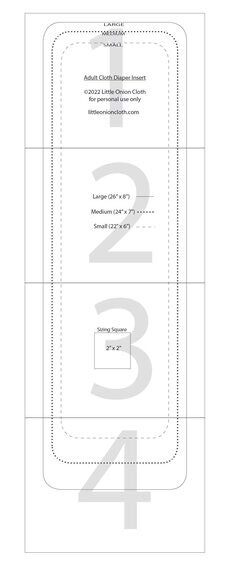
How to Sew a Prefold Cloth Diaper
Whew! Finding those calculations takes a bit of work, but are essential to getting the dimensions of your prefold right.
Now, we get into the sewing and folding portion of prefold creation. Honestly, it takes more mental effort than actual sewing to make a prefold, haha!
Step 1: Cut total width
The first step is to sew one long panel that is the total width and length needed for the prefold.
I need mine to be 94.5W” x 32”L.
Since the width of each yard of birdseye is 38”, I will need to cut 3 chunks of birdseye at 32”L.
Step 2: Sew total width
Next, sew each of the sections together, creating one really wide piece of fabric.
Cut to the length needed in step 5 of calculating fabric width.
For mine, that’s 94.5”W
Tip: if sewing a 4 ply prefold, sew your sections together in a tube shape or baste edges together. Treat the 2 resulting layers as one layer when folding.
Step 3: Fold the center layers
To fold the prefold, the ends get overlapped in the middle and sewn down. If we were to just overlap the ends in the middle as is, there would only be 3 layers of fabric.
So, I need to fold the ends an additional 5 times before the final folding. It doesn’t really matter how many times you fold over each end, as long as there are 5 folds total.
Stitch down the fold layers to secure them in place.
Step 4: Folding the prefold
Fold one side of the prefold to the center, stopping 7” from the other side. You can stitch here to secure the fold or you can finish folding and then stitch it all at once.
Next, fold the other side over and center the panels over each other. Pin and stitch down each side of the center panel.
Step 5: Finishing the edges
The final step to making a prefold diaper is to finish the top and bottom edges. Birdseye, gauze, and flannel all like to unravel, so it’s important to get a clean finish.
Serging is the traditional way of finishing the edges of a prefold, but no worries if you don’t have a serger! Most sewing machines come equipped with a variety of stitches.
Using a zigzag stitch multiple times across is the easiest, but you could also experiment with other stitches. Consult your machine’s manual to see what it can do.
Another option for finishing the edge would be to sew a strip of bias tape across. The bias tape will add more bulk, though, so keep that in mind.
Is it worth it to sew my own prefolds?
The total project time to create a prefold will probably take anywhere from 60 – 90 minutes. This includes calculations and sewing. It took me 1 hour to sew my prefold, but I did iron the 3 yards of fabric I used before folding. Also, since I was videoing it, I wanted to make sure my folds were precise.
Of course, it then got wrinkly again right away. Go figure. So unless you have deep creases that create ridges when you are folding your fabric, you can skip ironing before folding.
But let’s talk about time and money.
Everything is possible with enough time and money, right?
But for most of us, we tend to be lacking in one are more than the other. So before deciding whether to sew your own prefold or just to buy it, let’s consider a few questions.
1. How much does it cost to buy a new prefold in your chosen size?
The organic birdseye prefold in 4x8x4 from InControl costs $18 + $8.46 for shipping = $26.46.
2. How much will the fabric cost to make a prefold?
Calculate yardage needed and look up prices – including shipping – for your fabric. I got mine at Joann’s for $4.79/yard. Plus tax, the cost of my fabric was $15.45.
3. How much time will it take to make your own?
The prefold will take about an hour to make.
4. Is the savings worth your time to make the item?
In this case, if you have more time than money, making your own makes sense in this case. If not, you’d better off buying them. Check out my list of 6 Best Prefolds for Adults.
** Another option for saving time and money in making a prefold cloth diaper would be to make one with an absorbent pad in the center from another type of fabric. This will save you time in folding, as well as money in fabric yardage.
Sewing your own ALMOST ALWAYS is cheaper than buying. However, if the savings are minimal and your time is minimal, it might be better to buy some things rather than purchasing them.
Alecia
Latest posts by Alecia (see all)
- How to Make a Cloth Diaper Bigger - August 21, 2023
- Best Swim Diapers for Adults and Youth - July 18, 2023
- Adult Cloth Diaper Hacks: How to Make a Swim Diaper - July 14, 2023

